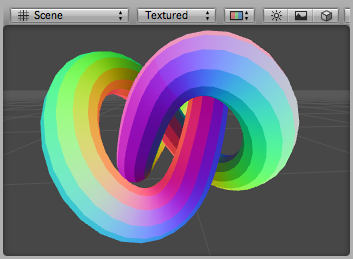Providing vertex data to vertex programs
For Cg/HLSL vertex programs, the vertex data must be passed in as a structure. Several commonly used vertex structures are defined in UnityCG.cginc include file, and in most cases it’s enough just to use them. The structures are:
-
appdata_base: vertex consists of position, normal and one texture coordinate. -
appdata_tan: vertex consists of position, tangent, normal and one texture coordinate. -
appdata_full: vertex consists of position, tangent, normal, two texture coordinates and color.
For example, this shader colors the mesh based on it’s normals and just uses appdata_base as vertex program input:
Shader "VertexInputSimple" {
SubShader {
Pass {
CGPROGRAM
#pragma vertex vert
#pragma fragment frag
#include "UnityCG.cginc"
struct v2f {
float4 pos : SV_POSITION;
fixed4 color : COLOR;
};
v2f vert (appdata_base v)
{
v2f o;
o.pos = mul (UNITY_MATRIX_MVP, v.vertex);
o.color.xyz = v.normal * 0.5 + 0.5;
o.color.w = 1.0;
return o;
}
fixed4 frag (v2f i) : COLOR0 { return i.color; }
ENDCG
}
}
}
If you want to access different vertex data, you have to declare vertex structure yourself. The structure members must be from the following list:
-
float4 vertexis the vertex position -
float3 normalis the vertex normal -
float4 texcoordis the first UV coordinate -
float4 texcoord1is the second UV coordinate -
float4 tangentis the tangent vector (used for normal mapping) -
float4 coloris per-vertex color
Examples
Visualizing UVs
The following shader example uses vertex position and first texture coordinate as vertex shader input (defined in structure appdata). It is very useful to debug UV coordinates of the mesh. UV coordinates are visualized as red and green colors, and coordinates outside of 0..1 range have additional blue tint applied.
Shader "Debug/UV 1" {
SubShader {
Pass {
Fog { Mode Off }
CGPROGRAM
#pragma vertex vert
#pragma fragment frag
// vertex input: position, UV
struct appdata {
float4 vertex : POSITION;
float4 texcoord : TEXCOORD0;
};
struct v2f {
float4 pos : SV_POSITION;
float4 uv : TEXCOORD0;
};
v2f vert (appdata v) {
v2f o;
o.pos = mul( UNITY_MATRIX_MVP, v.vertex );
o.uv = float4( v.texcoord.xy, 0, 0 );
return o;
}
half4 frag( v2f i ) : COLOR {
half4 c = frac( i.uv );
if (any(saturate(i.uv) - i.uv))
c.b = 0.5;
return c;
}
ENDCG
}
}
}
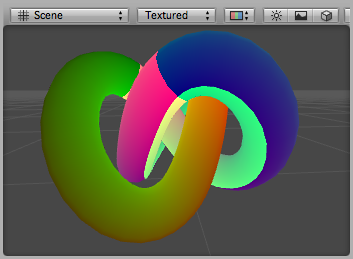
Similarly, this shader vizualizes the second UV set of the model:
Shader "Debug/UV 2" {
SubShader {
Pass {
Fog { Mode Off }
CGPROGRAM
#pragma vertex vert
#pragma fragment frag
// vertex input: position, second UV
struct appdata {
float4 vertex : POSITION;
float4 texcoord1 : TEXCOORD1;
};
struct v2f {
float4 pos : SV_POSITION;
float4 uv : TEXCOORD0;
};
v2f vert (appdata v) {
v2f o;
o.pos = mul( UNITY_MATRIX_MVP, v.vertex );
o.uv = float4( v.texcoord1.xy, 0, 0 );
return o;
}
half4 frag( v2f i ) : COLOR {
half4 c = frac( i.uv );
if (any(saturate(i.uv) - i.uv))
c.b = 0.5;
return c;
}
ENDCG
}
}
}
Visualizing vertex colors
The following shader uses vertex position and per-vertex colors as vertex shader input (defined in structure appdata).
Shader "Debug/Vertex color" {
SubShader {
Pass {
Fog { Mode Off }
CGPROGRAM
#pragma vertex vert
#pragma fragment frag
// vertex input: position, color
struct appdata {
float4 vertex : POSITION;
fixed4 color : COLOR;
};
struct v2f {
float4 pos : SV_POSITION;
fixed4 color : COLOR;
};
v2f vert (appdata v) {
v2f o;
o.pos = mul( UNITY_MATRIX_MVP, v.vertex );
o.color = v.color;
return o;
}
fixed4 frag (v2f i) : COLOR0 { return i.color; }
ENDCG
}
}
}
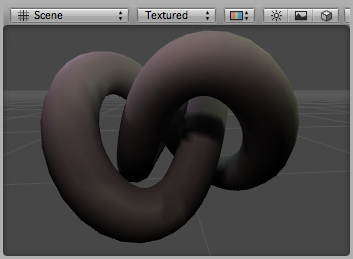
Visualizing normals
The following shader uses vertex position and normal as vertex shader input (defined in structure appdata). Normal’s X,Y,Z components are visualized as R,G,B colors. Because the normal components are in –1..1 range, we scale and bias them so that the output colors are in displayable 0..1 range.
Shader "Debug/Normals" {
SubShader {
Pass {
Fog { Mode Off }
CGPROGRAM
#pragma vertex vert
#pragma fragment frag
// vertex input: position, normal
struct appdata {
float4 vertex : POSITION;
float3 normal : NORMAL;
};
struct v2f {
float4 pos : SV_POSITION;
fixed4 color : COLOR;
};
v2f vert (appdata v) {
v2f o;
o.pos = mul( UNITY_MATRIX_MVP, v.vertex );
o.color.xyz = v.normal * 0.5 + 0.5;
o.color.w = 1.0;
return o;
}
fixed4 frag (v2f i) : COLOR0 { return i.color; }
ENDCG
}
}
}
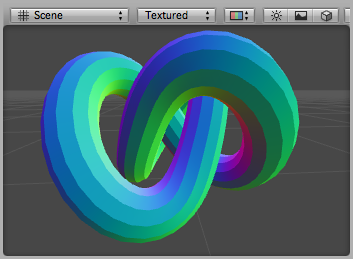
Visualizing tangents and binormals
Tangent and binormal vectors are used for normal mapping. In Unity only the tangent vector is stored in vertices, and binormal is derived from normal and tangent.
The following shader uses vertex position and tangent as vertex shader input (defined in structure appdata). Tangent’s X,Y,Z components are visualized as R,G,B colors. Because the normal components are in –1..1 range, we scale and bias them so that the output colors are in displayable 0..1 range.
Shader "Debug/Tangents" {
SubShader {
Pass {
Fog { Mode Off }
CGPROGRAM
#pragma vertex vert
#pragma fragment frag
// vertex input: position, tangent
struct appdata {
float4 vertex : POSITION;
float4 tangent : TANGENT;
};
struct v2f {
float4 pos : SV_POSITION;
fixed4 color : COLOR;
};
v2f vert (appdata v) {
v2f o;
o.pos = mul( UNITY_MATRIX_MVP, v.vertex );
o.color = v.tangent * 0.5 + 0.5;
return o;
}
fixed4 frag (v2f i) : COLOR0 { return i.color; }
ENDCG
}
}
}
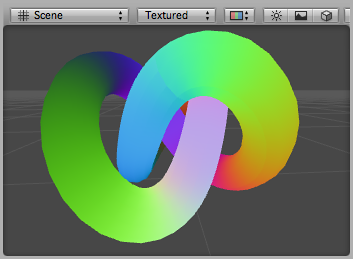
The following shader visualizes binormals. It uses vertex position, normal and tangent as vertex input. Binormal is calculated from normal and tangent. Just like normal or tangent, it needs to be scaled and biased into a displayable 0..1 range.
Shader "Debug/Binormals" {
SubShader {
Pass {
Fog { Mode Off }
CGPROGRAM
#pragma vertex vert
#pragma fragment frag
// vertex input: position, normal, tangent
struct appdata {
float4 vertex : POSITION;
float3 normal : NORMAL;
float4 tangent : TANGENT;
};
struct v2f {
float4 pos : SV_POSITION;
float4 color : COLOR;
};
v2f vert (appdata v) {
v2f o;
o.pos = mul( UNITY_MATRIX_MVP, v.vertex );
// calculate binormal
float3 binormal = cross( v.normal, v.tangent.xyz ) * v.tangent.w;
o.color.xyz = binormal * 0.5 + 0.5;
o.color.w = 1.0;
return o;
}
fixed4 frag (v2f i) : COLOR0 { return i.color; }
ENDCG
}
}
}
